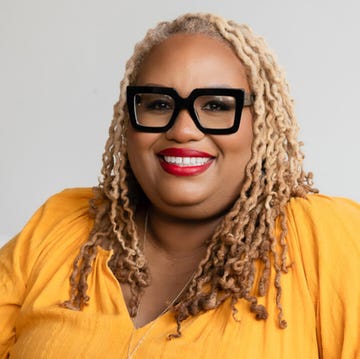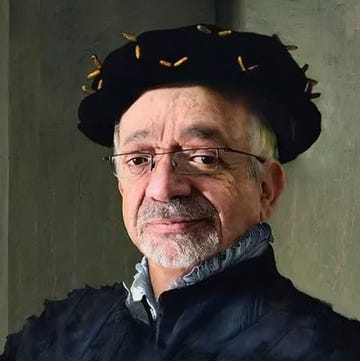Can artificial intelligence preserve us from the loss of death? This is one of the many fascinating questions Amy Kurzweil raises in her second graphic memoir, Artificial: A Love Story. Built in part around the artist’s relationship with her father, futurist and AI pioneer Ray Kurzweil, Artificial is a big book full of big ideas about identity, heritage, and technology. In that sense, it couldn’t be more timely. Yet perhaps most essential is its attempt to reckon with what we mean to one another and the extent to which love can truly matter when we are all destined to disappear.
Loss, love, and survival are deeply intertwined in Kurzweil’s work; her 2016 debut, Flying Couch, was a multigenerational saga, interweaving details of her own life with those of her mother, a psychologist, and her maternal grandmother, who escaped the Warsaw Ghetto. Something similar drives Artificial, which uses the dynamic between Kurzweil and her father to investigate the life of her paternal grandfather, Fred, a composer and professor, who fled Vienna in 1938 and died in 1970. It’s a loss from which her father has never quite recovered and one he hopes to use technology to rectify. “Like me,” she writes, “my father is a documenter. He doesn’t like to lose luggage or information.”
This is not merely a matter of neurosis, although it’s that, as well; when he travels, the senior Kurzweil packs his stuff in a grocery bag so it will not be checked. Even more, however, what he’s describing is a belief system, a matter of faith almost. “We are information: our memories, our skills, our personalities,” he insists. “We are patterns of information.” To prove the point, he has saved his father’s archive—journals, photos, programs, correspondence—with the intention of using it to seed an AI chatbot, which will bring the late composer back to life. That the idea is equally tantalizing and impossible is part of the point. “Someday,” he once told his daughter, “robots would be made of memory,” and in the uncanny valley of the present, he sees his work as a stepping stone, imperfect but necessary nonetheless. “There isn’t continuity,” he acknowledges. “And there isn’t—yet—a perfect re-creation of patterns.… But if it’s really done well, I could develop a relationship with it that’s similar to the relationship I did have.”
What he’s referring to, of course, is possibility. But in the context of Artificial, this becomes a complicated idea. The possibility of what? And how will it be actualized? Does he really believe that consciousness can be uploaded, that an inner life can be re-created in the circuitry of the cloud? His father’s chatbot highlights the depth of the conundrum; to be accurate—or representative, in some sense—it requires a broader sample than has been left behind. Setting aside the ethics of AI for a moment, this suggests the degree of difficulty involved. When it comes to Kurzweil’s grandfather, the selection is too limited and mostly involves written statements of his professional life. Query letters, job applications; because he worked as an adjunct after coming to the United States, his working situation was largely fraught. “His journals,” his son admits, “…they’re cryptic. We could have a human translate those notes into a full narrative. Then we could use that material in the bot.”
If someone else, however, adds an interpretive filter to the data, doesn’t that alter the experiment? I’m reminded of Schrödinger’s cat, the subjectivity of each observer, which means her grandfather “would enter the record quite differently depending on who and how the translator is.” To her credit, Kurzweil remains skeptical, even as she assists her father on his quest. The duality is illustrated in an extended sequence that reveals the limits of the so-called Dadbot Demo—a text scroll, really, into which she types questions to “communicate” with her late grandfather. The responses that come back are culled directly from his words. “His journals were so fragmented. They just didn’t translate into coherent language,” Kurzweil reflects. “…I’m not getting much of, like…his personal life.”
And yet, it is here, in this uncanny valley, that Artificial truly finds its voice. Like her father (and her grandfather), Kurzweil is an artist, which is to say an artificer. “Do you know about the concept of Kleos?” her partner, Jacob, asks during a phone call. This ancient Greek ideal, he continues, represents a “path to immortality. Like if you can be spoken about forever, you never really die.” There’s more than a little hubris in such a notion, and, anyway, if immortality is dependent on the memory of others, then how immortal can one ever really be? “The mortals,” Kurzweil observes, “are always challenging the gods’ designs and getting punished, but maybe it’s all a publicity stunt. Like Icarus and what’s-his-name.”
Kurzweil is doing something really interesting here—and on a variety of levels at once. First, she is employing the artifice of her own forgetting to contradict the promises of Kleos. What’s-his-name, after all, is Daedalus, another artificer, as Alison Bechdel memorably refers to him in her graphic memoir Fun Home, which Artificial resembles in some ways. Both are father-daughter books, and both import re-creations of photographs and typescripts, letters and handwriting, to enhance their verisimilitude. Such elements give the work a veneer of the documentary, even as they acknowledge the subjectivity of the artist’s eye. It’s a point made explicit during another conversation between Kurzweil and Jacob, after she is denied access to her grandfather’s information by the company that has helped her digitize it.
“It’s my grandfather,” she points out, not incorrectly.
“It was your grandfather,” Jacob amends. “The source material may be yours, or your father’s. But the way the words are recontextualized by an algorithm owned by a tech company may not be yours anymore.”
What Jacob is saying is that in the translation from physical to virtual space, material is necessarily re-rendered, becoming a reflection rather than a re-creation of itself. This is the same issue faced by her father in trying to make the Dadbot more multidimensional, or by Kurzweil in putting images on the page. Call it the churn of creativity, the reinvention required by the artist, the way we take in references and influences, then jumble them together to make something that is ours alone. “If my redrawings,” Kurzweil notes, “change the meaning of the original work, or function clearly as a reference, then they are part of a new work that’s mine.”
Artificial intelligence, in other words.
And what do we do about that? Kurzweil, thankfully, resists overarching answers; she is content simply to ask. “Our stories wake up and keep writing themselves,” she suggests of the digital future, in which our memories, our very selves, may survive (if at all) as code. “This future,” she continues, “sounds like liberation from the sadness of a story’s end. But it also sounds terrifying.”
Terrifying, yes, not least because it begs the question of whether there will be anyone to remember, anyone to hear. What good are stories if there is no one to engage with them, if they exist alone in virtual space? Kleos again, which is why the sadness of a story’s end is necessary, just as loss and love and survival become most meaningful when we acknowledge nothing lasts. I don’t want to die, but neither do I want to live forever. That’s the unbearable contradiction of existence, the defining aspect of our humanity. Or, as Kurzweil puts it: “None of us are fully knowable.… But I’m still listening.”
I’m still listening, as well.•













